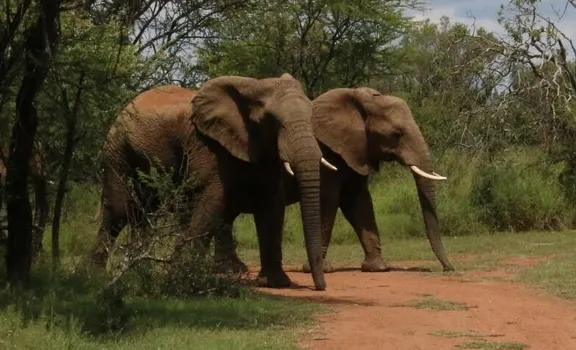The Elephant Journey, Part 3: Hot Stuff, Trouble at the Fence, and Lessons from the Giants

The Rise of Hot Stuff
When Charles and Lumpy departed Dinokeng for their new home in Mozambique, a vacuum was left behind. Into that space stepped Hot Stuff – a bull with all the ambition in the world but little of the wisdom needed to guide a herd.
Hot Stuff’s testosterone levels surged. His musth cycles stretched longer than usual, leaving him restless, aggressive, and unpredictable. He wanted the crown, but leadership among elephants isn’t just about who can swagger the most. It’s about patience, restraint, and earning the respect of the herd. Unfortunately, Hot Stuff’s style was more about brute force than diplomacy.
Gate-Crashing Glory
Still, Hot Stuff wasn’t without his talents. If Charles had been the original locksmith of Dinokeng, Hot Stuff was his eager apprentice turned master. He perfected the art of opening gates, snapping fence wires, and bending steel poles like paper straws. For the herd, this was a bonus: following Hot Stuff meant access to citrus orchards, marula trees, and all manner of human delicacies. For landowners, it was less amusing.
Some neighbours were enchanted by the sight of elephants at their fences and couldn’t resist tossing over treats. Others grew angry, banging pots, blowing horns, or starting up brush-cutters to chase the herd away. The result was confusion. The elephants received mixed messages – welcomed one day, chased off the next – and in that confusion, their boldness grew.
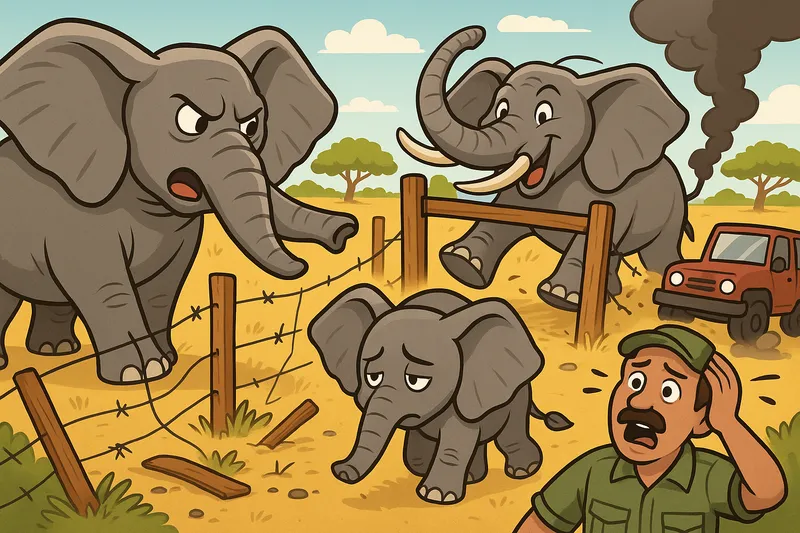
Chaos on the Rise: When Hot Stuff Took Over
By 2018, Hot Stuff’s mischief had grown into a full-blown crisis. Fence-breaking was no longer a seasonal sport — it had become a year-round obsession. Every few days, poles snapped, wires sagged, and gates swung wide open in his wake. What began as curiosity had turned into a test of strength, intelligence, and sheer determination.
Even the matriarchs had had enough. Tired of his constant bluster and bullying, the herd became restless, covering vast distances across the reserve in an effort to avoid their unruly companion. Their usual calm rhythm was replaced with agitation — a sure sign that the balance of elephant society had been disturbed.
For reserve management, each incident carried a price tag. By September, repair bills had climbed to nearly R1 million, and patience was wearing thin. The risk of the herd wandering toward the N1 highway — with devastating consequences for both elephants and motorists — could no longer be ignored.
See the remarkable YouTube footage that captures Hot Stuff in one of his most unforgettable moments — a masterclass in bushveld cunning and quiet power. With deliberate calm, he sizes up the gate, tests its secret, and then, with the finesse of an old hand, swings it open without breaking a thing. Moments later, he rumbles a deep call — the kind that carries through the thornveld — summoning his herd to join him in the marula feast that awaits beyond.
🎥 Credit to Owen Kilian for the unedited security camera footage. The real magic begins around the 5:25 mark — a patient watch rewarded!
A Heavy Farewell
The day we had all hoped to avoid finally came. In September 2018, with the situation slipping beyond control, the heartbreaking decision was made to put Hot Stuff down. It was not taken lightly, nor without many sleepless nights and heavy hearts.
For those of us who had watched him grow, from a fiery young bull into a troubled leader, it was a painful reminder of how delicate the balance is when humans and elephants share the same space.
Today, his skull rests at the Ndlovu Gate info centre. It stands not only as a stark reminder of what went wrong, but also as a quiet teacher: that true leadership is earned, not forced, and that when bad habits go unchecked, the cost is often far greater than we are willing to pay.
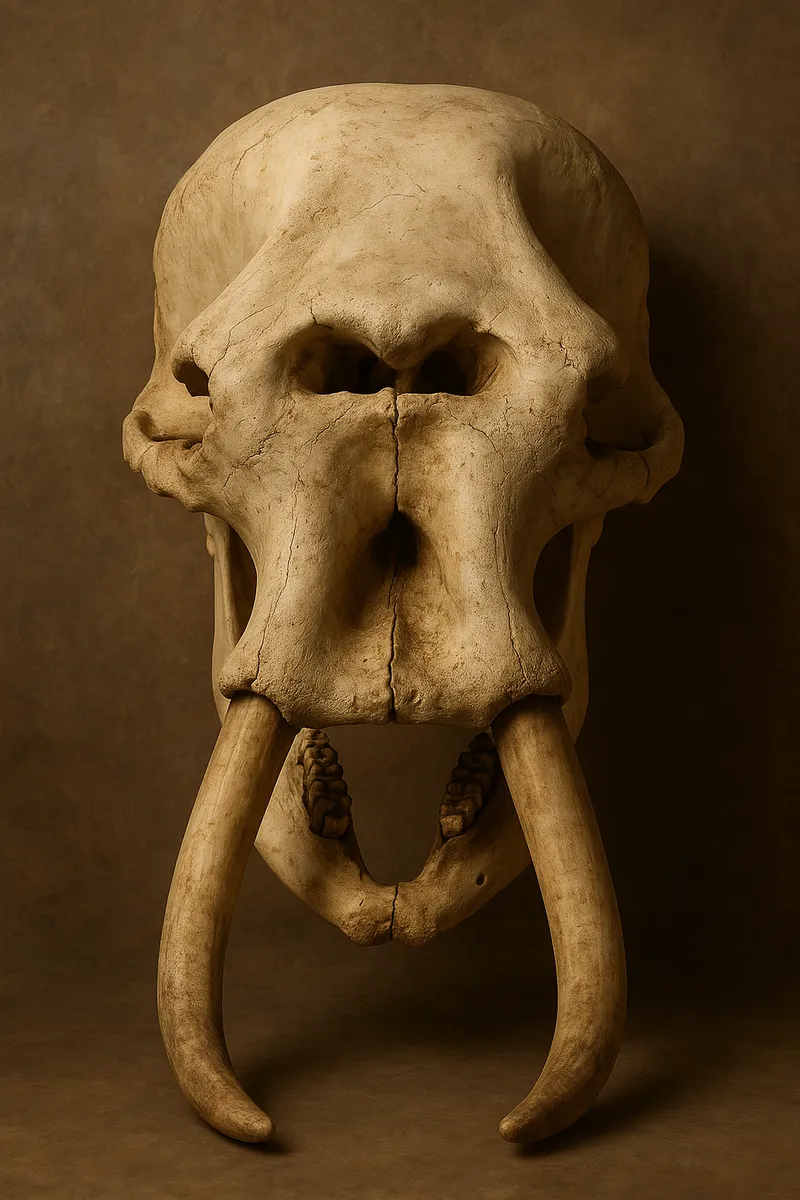
Calming the Storm: GnRH and the Younger Bulls
After Hot Stuff’s removal, the big question was: what now? The younger males were still around, and without guidance from older bulls, the risk of another rogue leader loomed large. In a desperate bid to protect them—and the reserve—we gathered advice from every professional we could find. Eventually, we settled on a bold and controversial idea: treating the young bulls with GnRH, a hormone usually linked to reproduction.
The plan was simple in theory but hotly debated in practice. GnRH, when used in a special way, dampens testosterone surges. For elephants, that meant shorter, calmer musth cycles—less aggression, fewer fences bent like wire toys, and a better chance of stability. Not everyone agreed. The decision sparked a small storm of its own, with experts on social media arguing for and against it.
But here’s the thing: it worked. The goal was never to tame the elephants, only to give them space to grow into balanced adults. And today, those same younger bulls still roam the Dinokeng bushveld—wilder, wiser, and far calmer than Hot Stuff ever was.
A New Herd Arrives (2019)

In 2019, Dinokeng’s elephant saga took another turn with the arrival of twelve elephants from Marakele National Park. Released into the northern wilderness, they brought fresh bloodlines, new dynamics, and the start of a new chapter.
At first, the newcomers and the founding herd kept to their own territories—the north and south. But elephants don’t stay strangers for long. Slowly, curiosity overcame caution, and the two groups merged into one large family, now guided by not one but two matriarchs sharing leadership.
In recent years, several calves have been born into the herd—a joyous sign that the population is thriving. It may also explain their peculiar routine. By day, the elephants stay in the north, but by night, they often wander south, only to return by morning. Perhaps these nightly excursions are more than simple wanderings. Maybe the mothers lead the herd south under cover of darkness to shield their young, using the cooler hours and quiet roads as added protection.
The bulls, of course, take their own approach. They stride through the southern bush as if on inspection duty, rearranging trees and reshaping the veld. One can almost imagine the matriarchs sending them south with a list: “Check the paths,, push down that tree, and make sure the humans remember whose land this is.”
Their night-time rambles, new calves, and bush-veld renovations only add more intrigue to a story that is still unfolding.
What Elephants Remember
If there is one lesson that Dinokeng has learned, it is this: elephants never forget. They know which fences carry current and which do not. They can sense whether a gate is electrified before touching it. And deep in their memories lies the knowledge passed down by Charles and Hot Stuff – that fences can bend, and gates can open.
This memory is both a marvel and a warning. Elephants are not only intelligent; they are generational teachers. What one bull learns, others observe. What one herd experiences, another may inherit. And so, as landowners, the responsibility falls to us to remain vigilant – to strengthen fences, maintain electricity, and avoid the mistakes of the past.
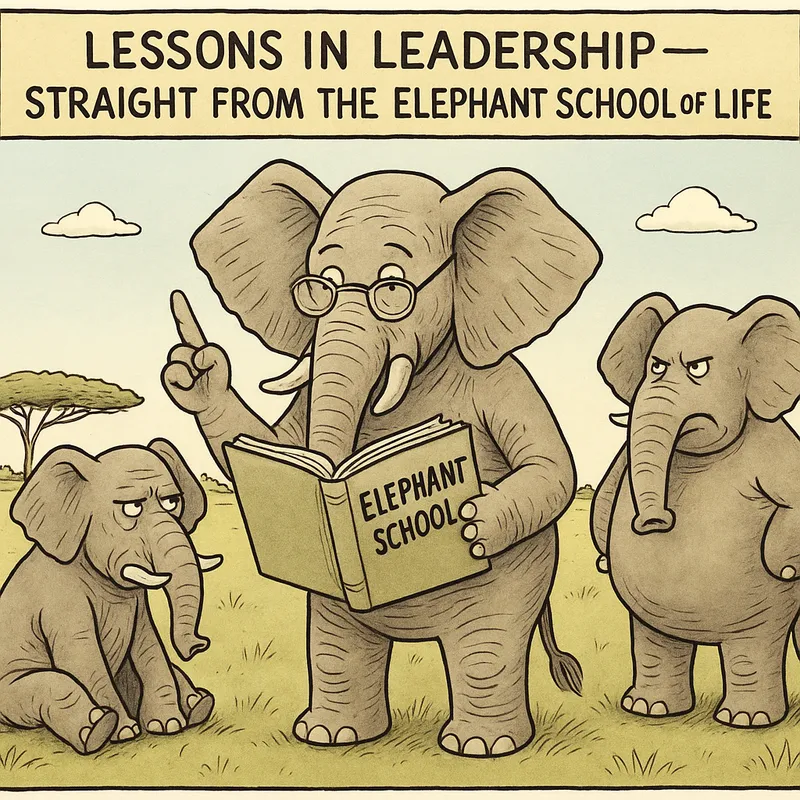
Lessons in Leadership — Straight from the Elephant School of Life
Looking back on the great saga of Charls, Lumpy, and Hot Stuff, it’s clear these elephants left us far more than broken fences and good campfire stories. They left us lessons — stamped deep into the Dinokeng soil, right alongside their enormous tracks.
Charls, the old gentleman bull, taught us that a fence is only as strong as its most overconfident landowner. With enough patience (and a trunk equipped with the dexterity of a Swiss Army knife), he proved that human engineering is, at best, a polite suggestion.
Hot Stuff, on the other hand, was all swagger and no subtlety. He reminded us that dominance isn’t leadership — it’s just noise. His rule was strong but short-lived, and his eventual fall from grace showed that power without restraint only leads to chaos (and a few very nervous gate owners).
Then came the toughest lesson of all — the one about us landowners. Every bucket of fruit tossed over a fence, every pot banged in frustration, every car horn blared in anger — the elephants noticed. They always notice. In their quiet, calculating way, they learned from our human behavior. Consistency, not commotion, is the only language elephants truly respect.
And just when we thought we’d figured them out, the elephants reminded us they’re storytellers too. Every toppled marula, every grapefruit neatly plucked from a branch, every mysteriously opened gate — all part of their ongoing narrative. A story they’ve been writing long before Dinokeng had a name, and one we’re lucky (and occasionally exasperated) to be part of.
When the Earth Itself Speaks
Elephant communication is a world of whispers most of us can’t hear. Researchers like Bob Preller, author of Silent Giants, and Dr. Caitlin O’Connell, author of The Elephant’s Secret Sense, have revealed that elephants don’t just talk through trumpets and rumbles — they also communicate through the very ground beneath their feet.
They “listen” with their soles, picking up faint seismic tremors that travel for kilometers — messages of danger, greetings from distant herds, or the tell-tale vibration of thunder that promises rain. It’s an ancient, earthbound internet of sorts — one that makes our Wi-Fi look embarrassingly limited.
And then there’s Lawrence Anthony, the legendary Elephant Whisperer, who proved that connection doesn’t always need translation. Sometimes, understanding comes from patience, respect, and a willingness to stand quietly long enough to let the bush — and its giants — speak first.
The Story Continues
Today, Dinokeng’s elephants roam with more calm than chaos. The herds graze, wander, and sometimes drift down to the fences—still met with awe, respect, and the occasional nervous glance. The younger bulls grow under careful guidance, the matriarchs hold steady with their quiet wisdom, and landowners keep adapting—one fence pole at a time.

What the Elephants Mean to Thorn Tree
For us at Thorn Tree Bush Camp, the elephants have never simply been neighbors beyond the fence. From the day Charles bent his way into our grapefruit tree, they became part of our story. We’ve lived through their mischief and majesty, the heartache of translocation, and the lessons of bulls like Hot Stuff. We’ve felt the frustration of broken fences and the wonder of nights when the herd lay quietly just outside, as if standing guard.
Being involved in their management—walking alongside conservationists, debating hard choices with landowners, and holding onto Dinokeng’s vision—has been humbling and heart-sore. It has shown us that conservation is not tidy. It is compromise, sacrifice, and above all, a commitment to a dream far bigger than ourselves.
For Dinokeng, elephants were the stamp that turned vision into reality. For Thorn Tree, they have been our greatest teachers—reminding us daily that we are only temporary custodians of this land, and that every guest who sits at our fire becomes part of their unfolding story.
And so, this trilogy of tales—of arrivals, of departures, of fence-breakers and night-wanderers—is not really an ending. It is simply a pause. Because in Dinokeng, the giants still walk, their saga still unfolds, and their footsteps will continue to echo long after ours have faded.
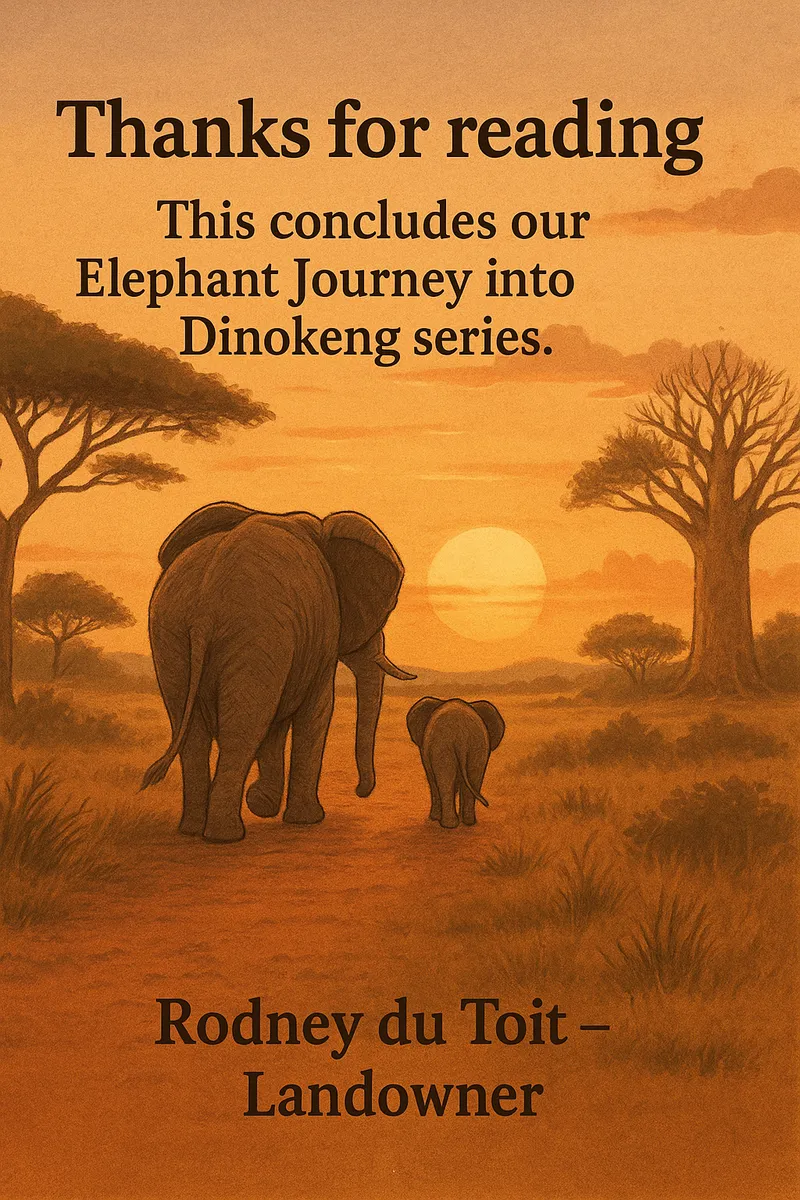
This marks the final chapter in our Elephant Journey into Dinokeng series — but certainly not the end of the story of our magnificent elephant neighbours. We’re privileged to share our bushveld home with these gentle giants, and they never stop giving us new tales to tell.
Keep an eye out for the next chapters they’ll write — in footprints, fence repairs, and unforgettable moments.
Thank you for reading, and for joining us on this journey. I hope you’ve enjoyed discovering their world as much as I’ve loved sharing their lessons and stories with you.
